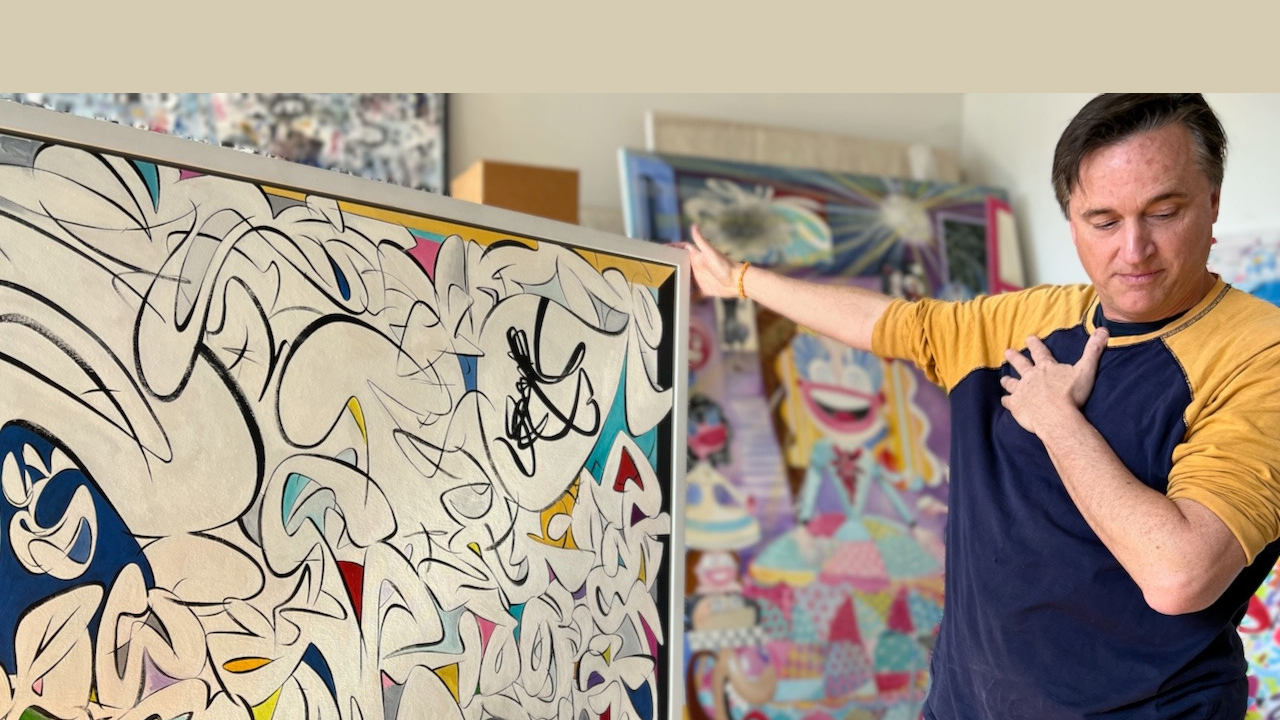
John Dempsey, whom I have known thirty years, may be the best still-affordable painter you have never heard of. He calls his fluid, colorful work Pop Abstractionism, and his influences include early Picasso, the botanical world, and graffiti. In 2010 he won first place (and $25,000) for his painting The Great American Landscape in Art Loop Open, Chicago’s first public voting contest.
Or, maybe the best-affordable distinction belongs to painter Billy Tokyo, who arrived on the scene more recently and is influenced by the Chicago Imagists and Japanese pop art that blurs the line between fine and commercial art. The Elmhurst [Illinois] Art Museum wrote of his work, “Embracing a psychedelic rainbow palette, Tokyo packs every inch of space with commentary on contemporary culture and skewers stereotypes with ample wit and humor.”
Dempsey’s website claims “[b]oth artists share a studio” near Chicago’s Loop, but as with so many things, this is a goof. John Dempsey and Billy Tokyo live and work in the same mind.
“Life is too short to be just one artist,” Dempsey writes.
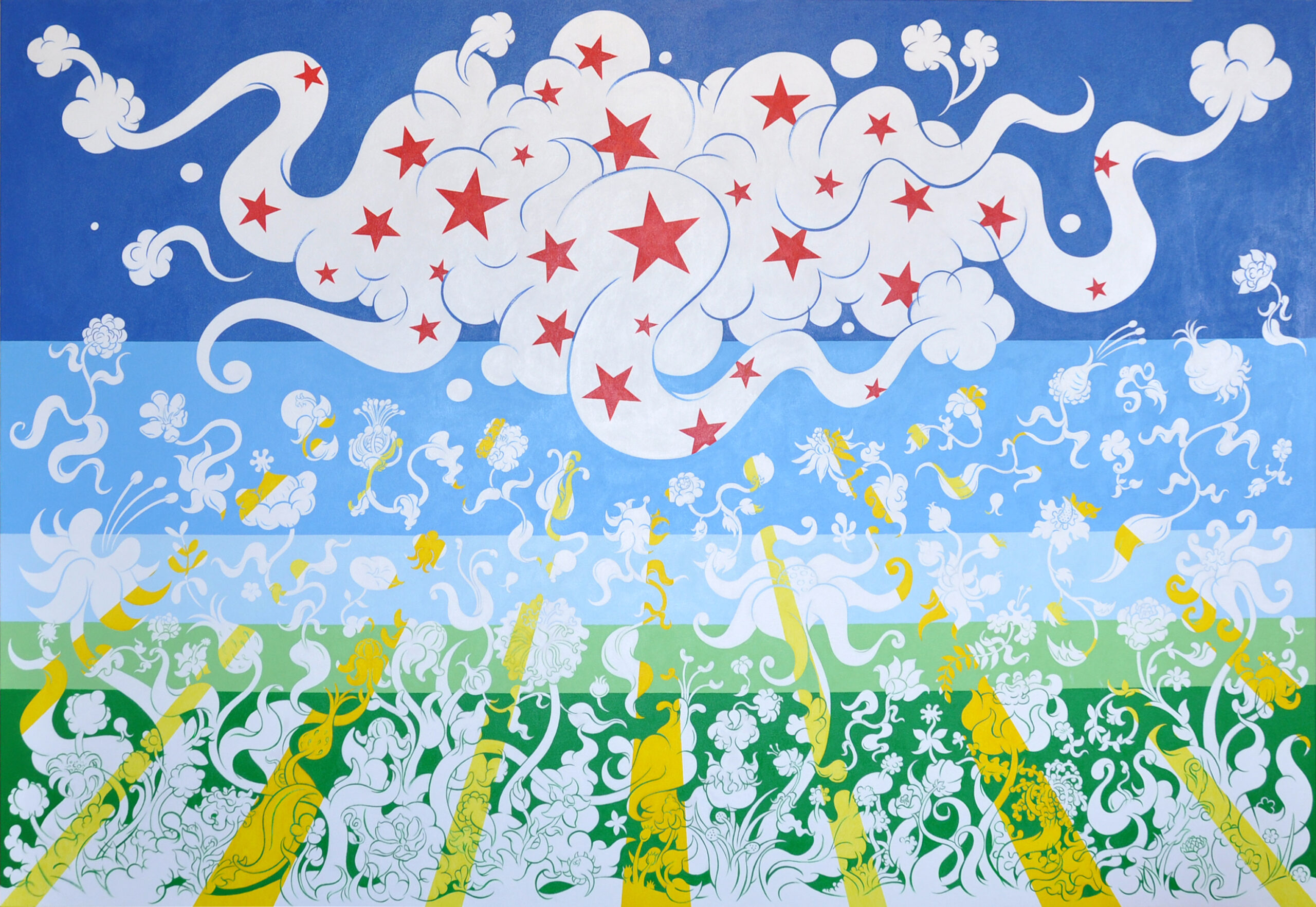
The Great American Landscape, by John Dempsey (Photo by John Griswold)
• • •
John Thomas Dempsey IV was born and raised in the affluent Chicago suburbs. His grandfather (JTD II) was an Illinois Appellate Court judge and active in Chicago politics. His father (JTD III) still takes the train downtown weekdays to work as a financial analyst at 86. Theirs is a big, lively, Irish-American family that has spent summers since the 1920s at a private club on a lake in northern Wisconsin, their midwestern Hyannis Port.
Dempsey studied art under Æthelred Eldridge, a multi-disciplinary artist who taught at Ohio University for 56 years. Eldridge, whose real name was James Edward Leonard Eldridge, was known for “eschew[ing] self-promotion,” OU’s College of Fine Arts said after his death in 2018, and for being “complex, idiosyncratic, and sui generis: a singular artist with boundless creativity.” He was the type of teacher remembered as “storied.” Eldridge founded what he called Golgonooza, the Church of William Blake, on his property north of Athens, Ohio, and Dempsey’s paintings show the influence of both Eldridge and Blake’s influence on Eldridge.
Dempsey’s website claims “[b]oth artists share a studio” near Chicago’s Loop, but as with so many things, this is a goof. John Dempsey and Billy Tokyo live and work in the same mind.
John Dempsey says he was also mentored by Cortland Anderson, director of the EW Scripps School of Journalism at OU. Anderson had been vice president of corporate affairs at The Washington Post Company and executive vice president of the Corporation for Public Broadcasting. He encouraged Dempsey, who drew a daily cartoon called Big Guy on Campus for the college paper and was already syndicated to other college newspapers and a national college magazine, to reach an even wider audience.
Dempsey graduated with a bachelor’s in Journalism News and Information in 1988 and went to work in corporate advertising and marketing, but he has never stopped painting. His work has always sold, by his own self-deprecating assessment, in modest quantities—he too “eschews self-promotion”—at shows and by commission.
In 2008 he was commissioned to draw illustrations for his beloved Chicago Cubs and for festivals such as Lollapalooza and South by Southwest. He told Chicago galleries that he created his alter ego, Billy Tokyo, then, because he was “[c]oncerned with pigeonholing himself in the world of commercial art.”
He told me something more interesting. The truth is anyone’s guess.
• • •
I met John Dempsey in the advertising department of a Fortune-1000 company that sold office supplies by catalog. There, two dozen of us knew him as “Jack.” (Later I was surprised when none of his extended family knew he had been going by Jack.)
He and I were hired as copywriters, but in the jargon of business, some of us there did not have corporate-facing personalities. When it was absolutely necessary, Dempsey “wrote” charts filled with printer-cartridge SKUs and pricing in five-point type, and I enthused over reams of copier paper. There is a reason that The Office, set in a paper-supply company, exists in 15 international versions, all presumably portraying the same thing: sometimes people must work jobs that bore or limit them, and they hope for more.
Some months after I arrived, Dempsey quit. I was sorry to see him go. When he left on his last day everyone rushed to the windows, as if it were The Office, to see how he would say goodbye. He mooned us from the sidewalk, waved, called us suckers, and shouted well wishes.
Still, in the many lulls between catalogs, employees did their own work or none at all. Dempsey made sketches for paintings and used copiers to make clip-art collages. He and his cousin had a fake cable-TV show called Wishin’-N-Fishin’, for which John played a character named BillyJoeJimBob. During work he wrote letters to dozens of famous people to ask them to be on the show. Kurt Vonnegut sent amused regrets, doodled his famous self-caricature, and told BillyJoeJimBob to contact his good friend Betty Friedan, “the great and darling feminist from Peoria,” whom he was sure would love to do it.
(Dempsey had in mind to publish a book of these letters, just as Don Novello, who played Father Guido Sarducci on Saturday Night Live, had published his own letter-exchanges as Lazlo Toth. The Vonnegut response was eventually published here.)
Some months after I arrived, Dempsey quit. I was sorry to see him go. When he left on his last day everyone rushed to the windows, as if it were The Office, to see how he would say goodbye. He mooned us from the sidewalk, waved, called us suckers, and shouted well wishes. The young graphic artists from McHenry County screamed and laughed.
When I could, I moved on too. Some of us were hardheads, intent on living as we chose, though it might be true that, adjusted for inflation, I never made that much money again, in or out of academe. In a few years the company was sold for $700 million, and some employees also got options in the buyout. It began selling reams of “Dunder Mifflin” paper—never quite in on the joke but laughing all the way to the bank.
• • •
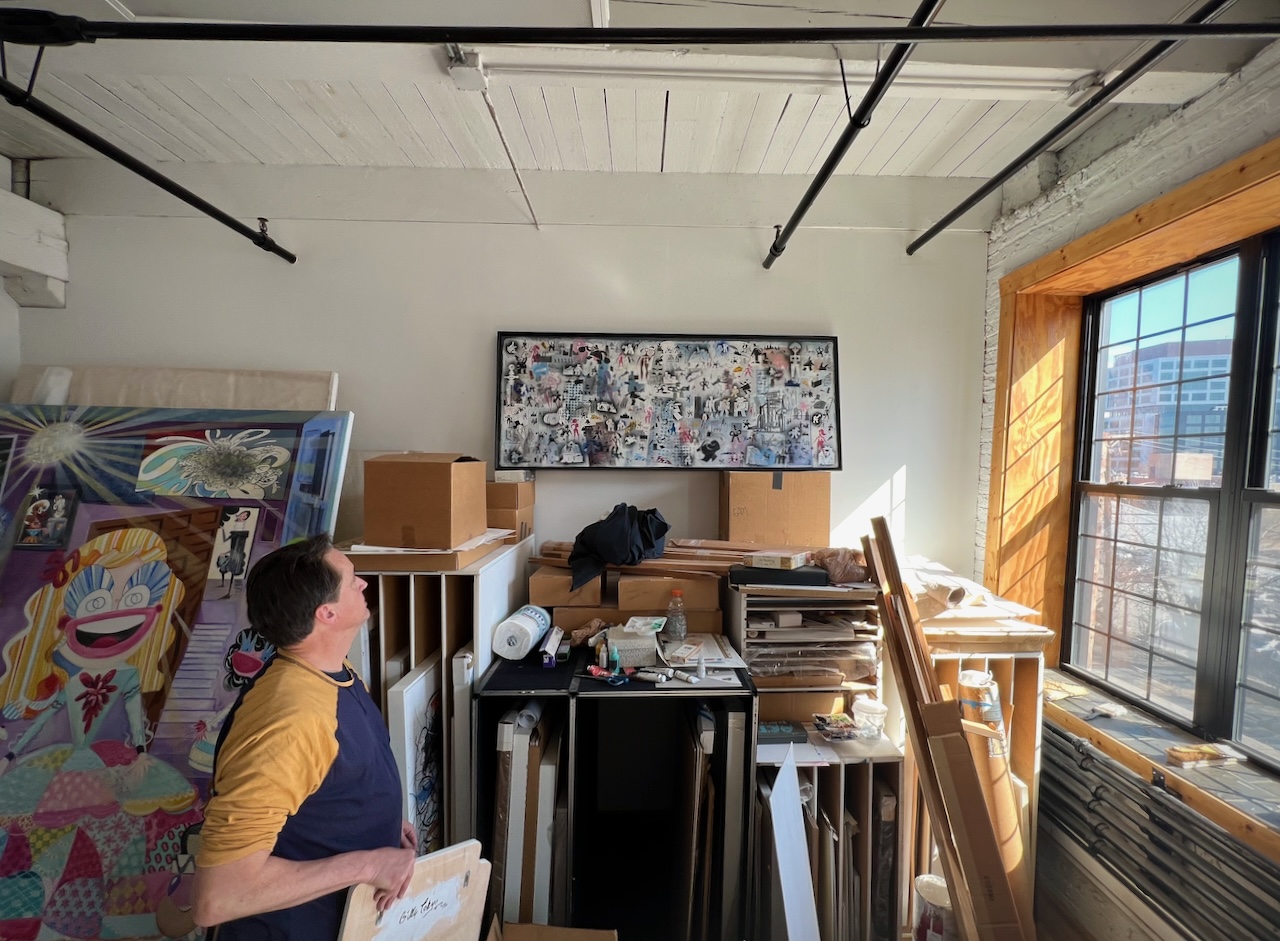
(Photo by John Griswold)
The funniest thing about that corporation was that, because John Dempsey was full of jokes and antics, because he was always “on,” and because he pranked coworkers mercilessly, many there thought he was just a goof. (In their defense, he can be exhausting. I have driven to northern Wisconsin with him on a winter’s night in his open convertible, and the first thing he did when we arrived was prank me.)
Dempsey has worked forty years at The Thing, devotedly and to his own sensibility, at no small personal or financial cost, and often without proper recognition or reward other than the hard satisfaction of living in process.
But he is also conscientious, even perfectionist, in his work, and his life has proved more stable than most of ours. He left to be an art director for Thomas the Tank Engine (US) then for Crescent Brands, a renowned wholesaler of artists’ materials. He still lives and works in Chicago, has been married for seventeen years, and has two great kids.
Above all, he has painted through—and, no doubt, often despite—the demands of money-work, family, children, friends, wellness, home ownership, and all the other often lovely things that can sap talented people of creative energy.
Dempsey has worked forty years at The Thing, devotedly and to his own sensibility, at no small personal or financial cost, and often without proper recognition or reward other than the hard satisfaction of living in process. This is more remarkable than anything else I might write about him, from his compulsive use of pseudonyms to the kind of brushes he uses.
• • •
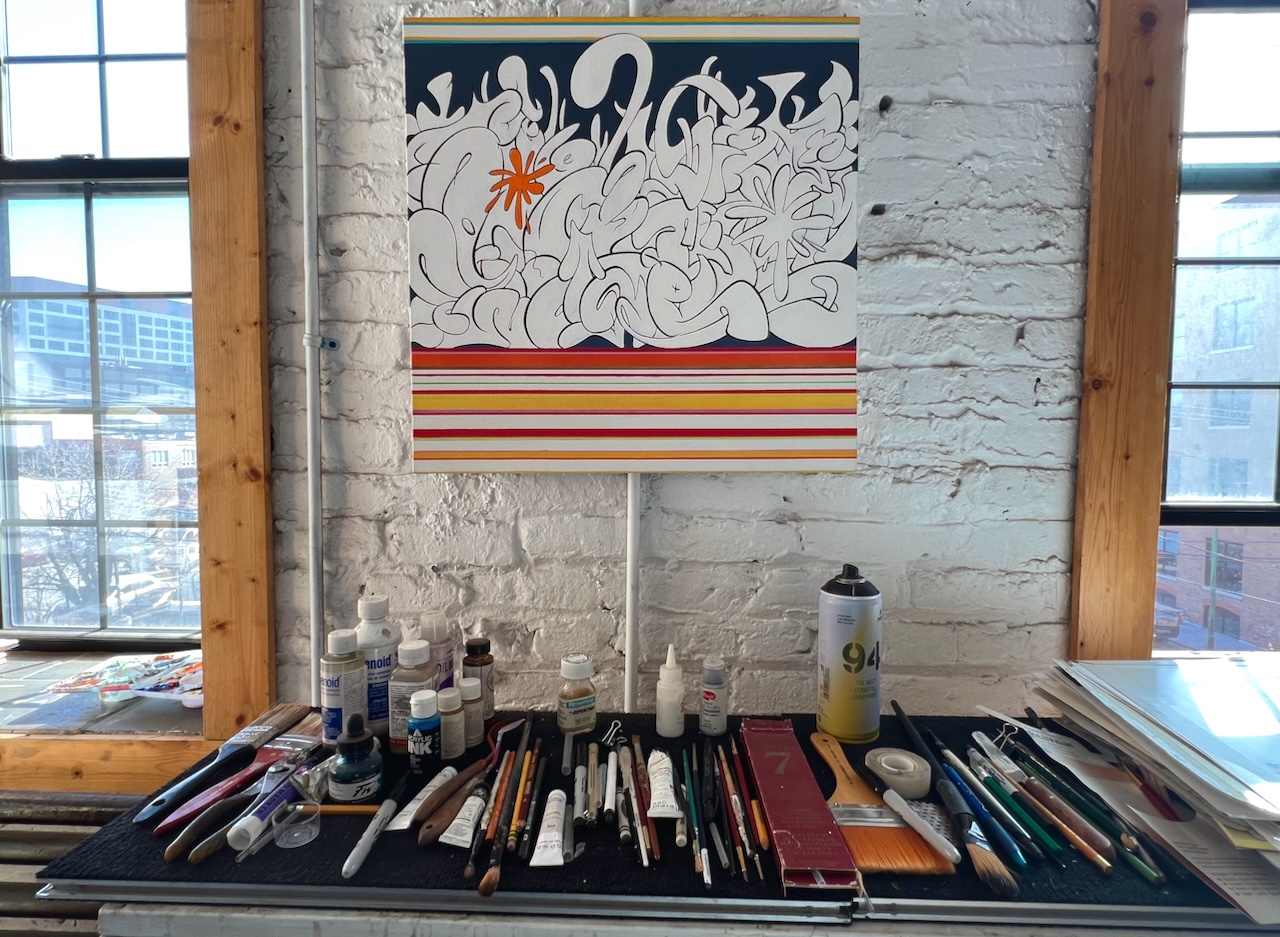
John Dempsey’s studio work table (Photo by John Griswold)
John Dempsey pointed our attention to the Series 7 Kolinsky Sable Watercolor Brushes from Winsor & Newton on his work table and said he had “gone through dozens of boxes.”
“They have Russian sable bristles and are what King Charles uses. You can’t get them in the States; they cost hundreds of dollars,” he said in the invented voice of a pompous guy pretending to be nonchalant. (He has also generously given away boxes to artist friends.)
I had not seen John in person for fifteen years. In March my younger son and I met him on a sunny, warm morning at the Guinness restaurant in Chicago. Other than sunspots on his well-tanned face, from fishing, he had not changed.
Over a full Irish breakfast and stout he told my son stories in a faux-excited voice: how one time at work he and I were walking down the corridor between the copywriters and the graphic artists, and he farted loudly—Brrrrap-flap-flap—and ducked out of sight so I would get the blame. My son was laughing too hard to eat his mushrooms, tomatoes, and beans. John told him how all the artists, most of them women, looked up to see only me standing there, and how my face turned red when I laughed, so of course they knew I did it. He told us how he dresses as a super-fan in a special hat when he goes to Cubs games and is often on TV because they love his energy. He told us about being a dad.
When we finished eating, we drove a few blocks to his studio in the Fulton Market neighborhood, the old meat-packing district. The eight-story building where he rents a space used to be a chicken-plucking factory. The neighborhood is changing rapidly now—Google has moved in down the street—but someone was shot nearby recently. For years he painted late at night, but one time when he had finished, at 1 a.m., he got on the Kennedy Expressway to go home, and a drunk driver flew past, going the wrong way, and hit a truck. Now he works at his studio weekend mornings. At home he only uses watercolors, because he does not want to expose his family to toxic chemicals.
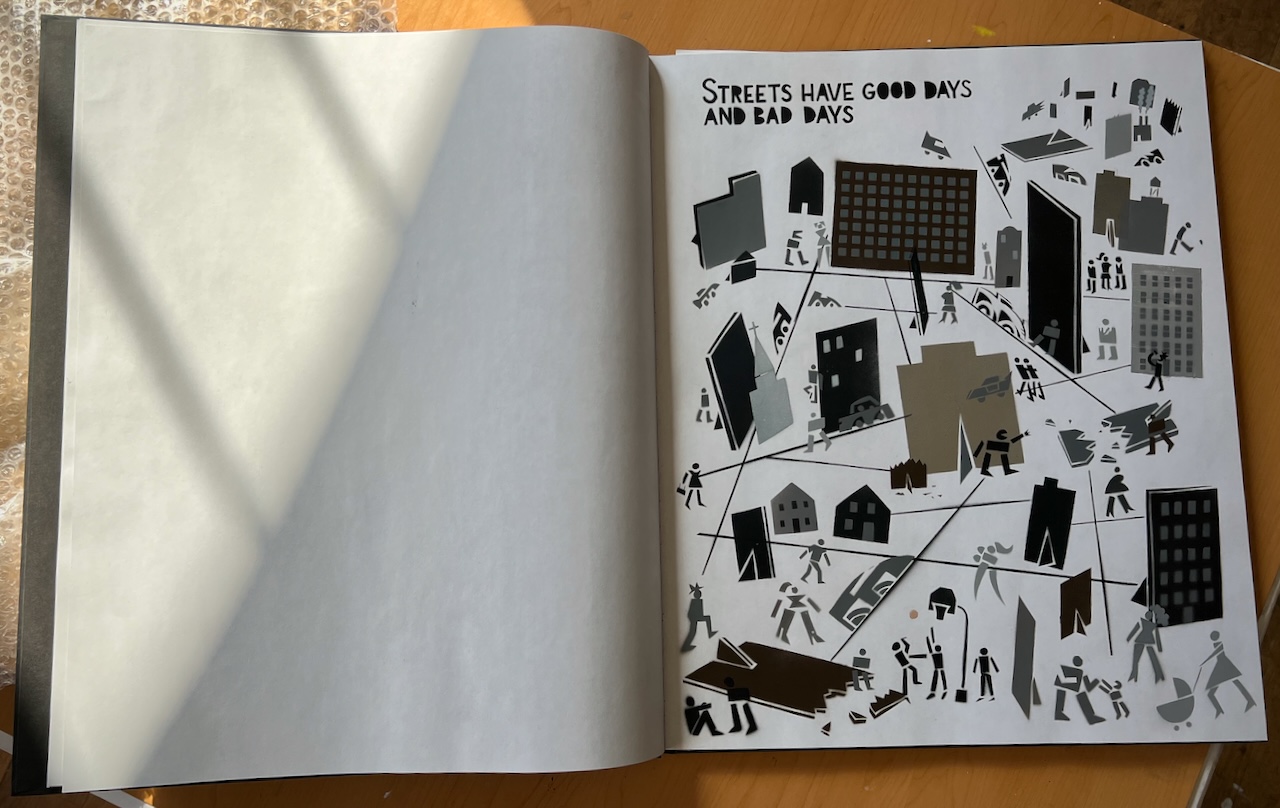
Murder Won’t Stop Shooting. by Billy Tokyo (Photo by John Griswold)
We walked up the industrial stairs and down a hallway with metal doors. He unlocked one and opened it to a room redolent with paint in spray cans and flattened tubes on credenzas and shelves. Sun poured through large windows onto a dozen paintings, some finished and others not, on easels and the floor; everything else was stored in six-foot high, segmented, vertical bins and archival boxes.
I asked where the thousands of paintings were that I knew he must have done over the years. He said he hoped they were “with collectors who care about them still.” The inverted syntax meant comic evasion, so I pressed, and he said he had “no idea” how many paintings he had sold in the last twenty years. I tried once more.
“Oh, I don’t know,” he said. “Fifty maybe. Fifty real pieces, I should say.” There had been events too, such as open houses at his building, where other things sold. He had forgotten to photograph them, so they had faded from memory.
“But I was doing so much stuff,” he said. He pointed to a stencil he had hand-cut and used over and over with spray paint. “I did this in a zillion different colors. And things sell online, or at shows. [O]nce a year, at museums…you donate a piece and the museum keeps half and the artist gets half or a third…. You get a lot of attention that way. Collectors will call you up.”
Since his kids had gotten older, he said—especially since his son had gotten into baseball—there had been less time for sales.
I asked where the thousands of paintings were that I knew he must have done over the years. He said he hoped they were “with collectors who care about them still.” The inverted syntax meant comic evasion, so I pressed, and he said he had “no idea” how many paintings he had sold in the last twenty years. I tried once more.
I was still bothered and asked if he had more art in his basement at home. He smiled about as much as Mona Lisa.
“I always throw stuff away if I look at it and it’s not up to snuff,” he said. What he had here was it, he claimed.
He showed us work for two hours, but much of that time we were talking, catching up, comparing notes, or he was sliding paintings in and out of storage bins and opening boxes, looking for something specific, not finding it, then being frustrated when things would not go back where they were meant to be.
• • •
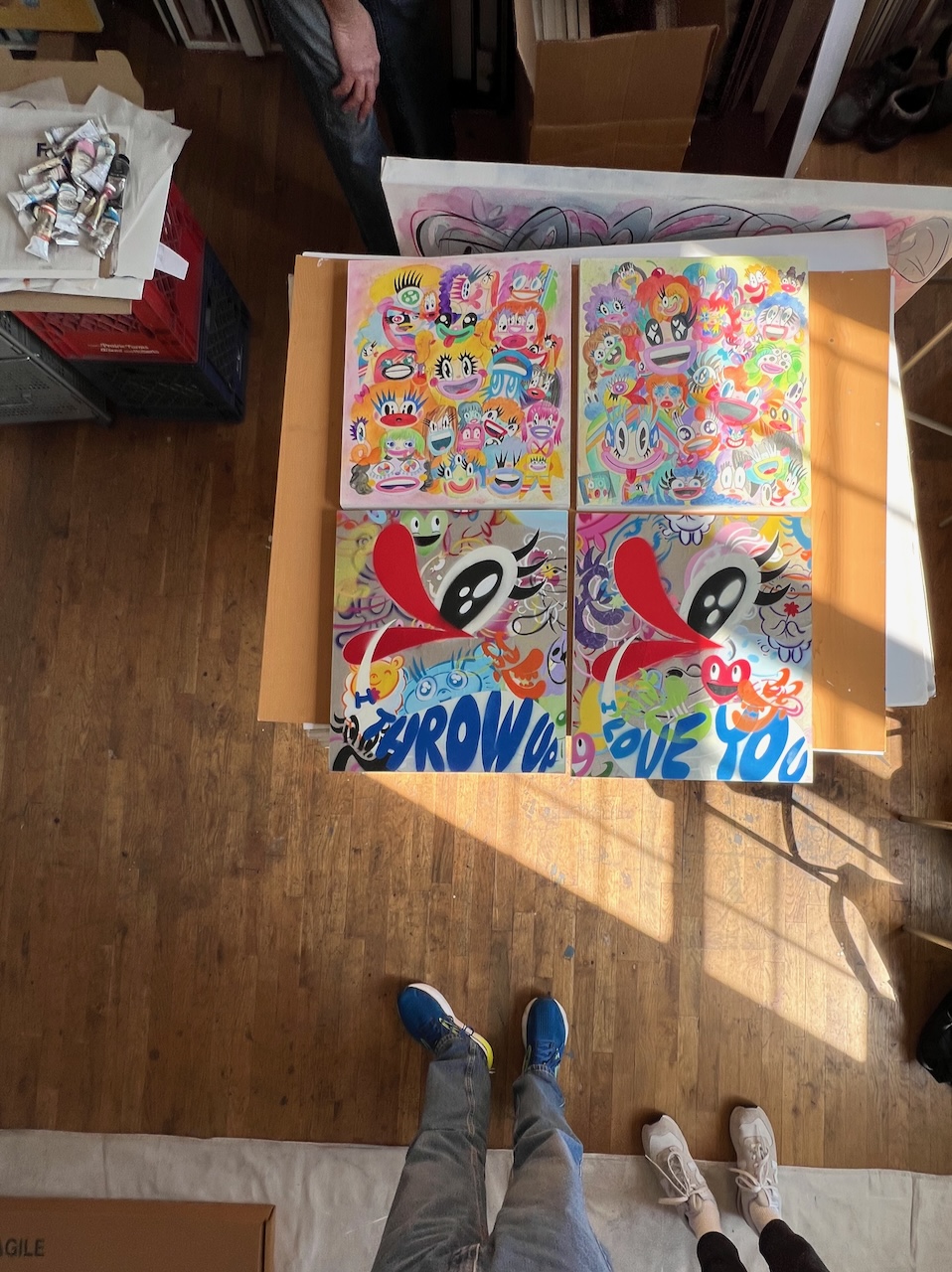
(Photo by John Griswold)
In broad strokes, the difference between the styles of John Dempsey and Billy Tokyo is that Dempsey’s paintings are abstract—arcs and loops given depth by layered media—and Billy Tokyo’s are figurative (“but ‘Pop-py,’” Dempsey insisted) with distorted settings.
“This one’s a baseball picture,” he said of a large, unfinished Billy Tokyo on an easel by the door. The cartoonish people in their stadium seats looked manically excited to be there. “This beer vendor’s gonna be, like, Aaaaaaa, like the horse in Guernica,” he said.
He pointed to a painting next to it, also a Billy Tokyo but darker and more claustrophobic. The clothing and cars were anachronistic; buildings were false fronts propped up with sticks.
“This is the kind of stuff I do now, people walking around the city. Everyone’s on their cell phones. That’s me,” he said, pointing.
One of his stencil figures, a Monopoly-style tycoon on a beast trampling a worker, was spray-painted flatly in the center of the canvas. It had a very 1930s look. He said he admired Max Beckmann and other Weimar artists for their distorted styles and social criticism.
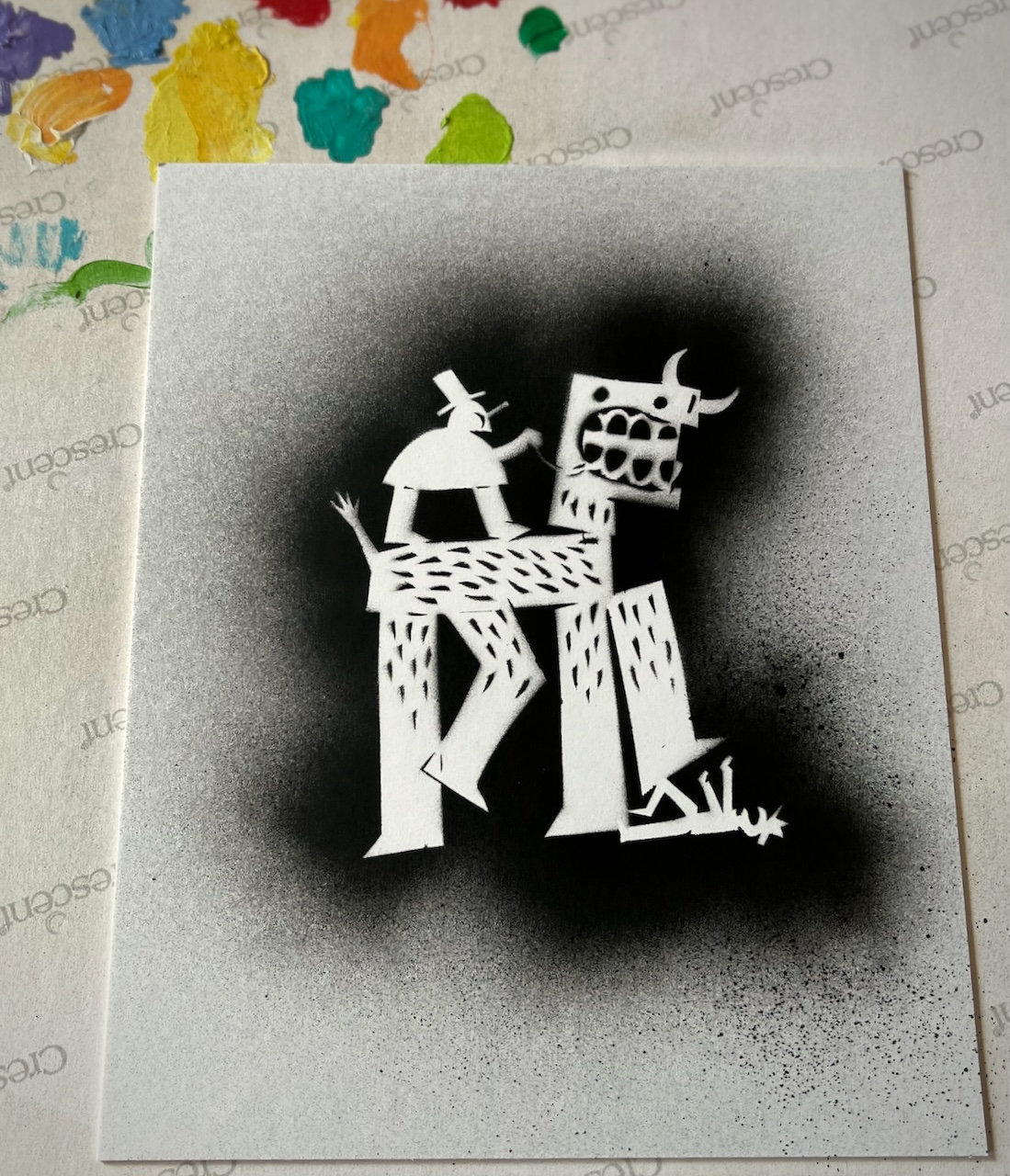
(Photo by John Griswold)
(Dempsey’s joking has always masked his love of art history and reading. When we met he was an amateur scholar of the Lost Generation and introduced me to Morley Callaghan’s That Summer in Paris: Memories of Tangled Friendships with Hemingway, Fitzgerald and Some Others (1963). The Elmhurst museum mentions Dempsey’s interest in Foucault. At the same time, the intended cosmopolitanism of the surname Tokyo might prove problematic.)
Dempsey pointed to the biggest painting in the studio, six by five feet, and challenged me to identify what work it paid homage to. I could not quite get it.
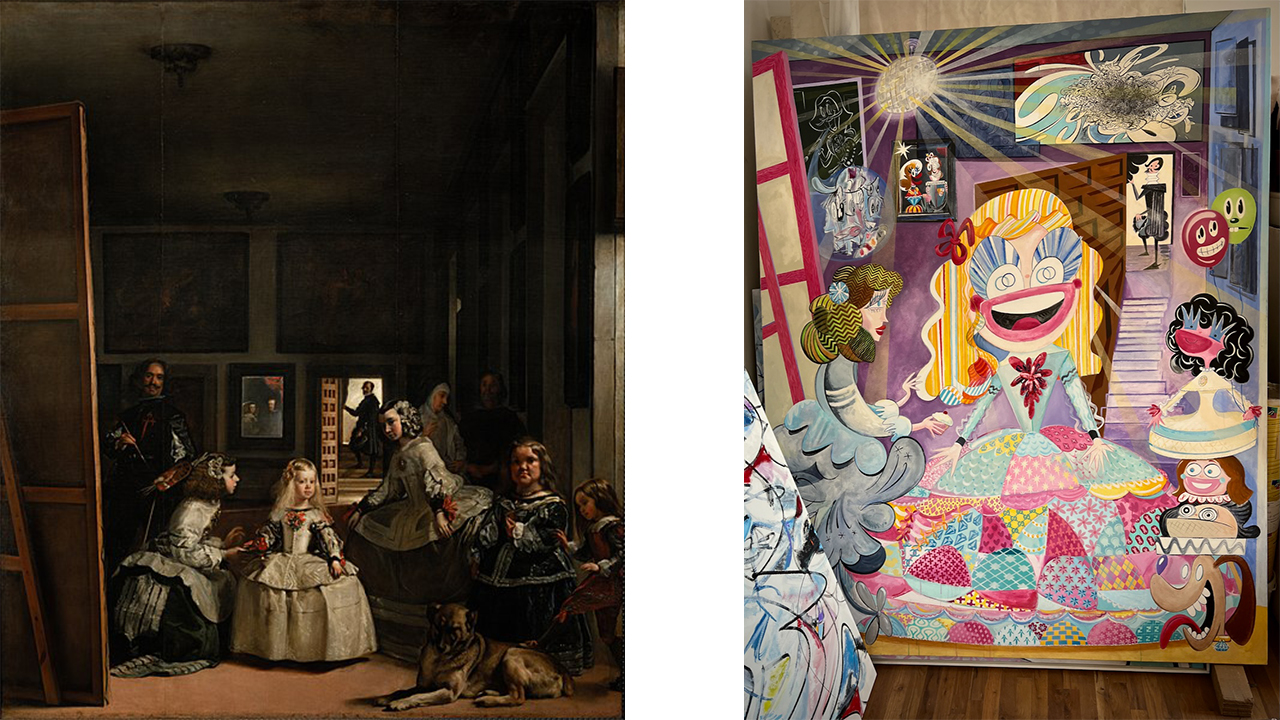
Las Meninas, by Diego Velázquez (left) and John Dempsey’s version of the Spanish painter’s masterpiece. (Photo at right by John Griswold)
“Velazquez,” he said triumphantly. “One of the most famous paintings in art history. Las Meninas.” He pulled up the original on his phone and compared its figures to ones in his own painting. “This is the princess,” he said. “This is her court. That’s Diego right here, painting. This guy is like a dwarf or something. There’s the king and queen in the mirror…. It’s real pop-py.”
My son and I admired it.
“Who would do this painting?” Dempsey half-shouted for effect. “Who would do that? Some guy called Billy Tokyo! It doesn’t look like some guy called John Dempsey did this. But it looks like—Oh! That looks like a Billy Tokyo! It’s a mix between Eastern and Western art….”
Galleries, he said, “want you to be under one name. You know: Oh, that looks like a John Dempsey. Well, who’s this then?”
He began to search the slots in the bins again. “There’s some stuff [here that’s] never seen the light of day.” More rustling and scraping. “I had forgotten about this piece,” he said, pulling out an Etheridge-like painting with hand-lettered text. “For a while there I was incorporating a lot of words. Now I look at this and think, Wow, I could have been much more original with this stuff. But I don’t think I wanted people to be really reading it as much as I wanted them to look at the overall scene.”
“I’m not concerned with selling anymore,” he said. “I’m concerned with making the best images I can make. […] I have a day job for a reason, so I don’t have to put up with the bullshit of a gallery. …”
“I’ll show you one of my favorite pieces,” he said and held up an abstract John Dempsey. “Here, this is all spray paint. I think it’s 500 different stencils, put on top of each other…. I come to the studio and there’s graffiti on the walls. The lines, how they intersect, how they move, flow: I take the lines of the tags and break them apart. Then I can make them into compositions. Coming up with something original that’s abstract is getting tougher and tougher; there’s so much stuff that’s been done.”
He pulled out another painting. “This is a chucker,” he said. “This is something I’d chuck.”
Another: “Mm-hm. Don’t like it. Don’t like it. Might paint over it, we’ll see. Not everything can be…you know.”
Another: “Why did I paint this?” He said a museum had wanted something “’very Billy Tokyo.’ Now I hate it. So I’m going to paint over it. I like the frame. I got the frame special….”
A stenciled piece: “See, that is—we call it a hot mess.” He said he was trying a technique: “The noise would be the depth of the painting. The colors behind it.” The process of using the stencils, he said, became almost as interesting as the finished painting.
“I’m not concerned with selling anymore,” he said. “I’m concerned with making the best images I can make. […] I have a day job for a reason, so I don’t have to put up with the bullshit of a gallery. You know…it’s good to have deadlines, because you get stuff done [but] I don’t have that need to get more stuff done, [so] I can do my own stuff, for me. I don’t have to paint for someone else.”
He was distracted by finding a piece of art board he had covered with paisley French wallpaper and painted with a happy little jelly bean that had bunny ears and a cottontail.

(Photo by John Griswold)
“That is contemporary pop art right there,” he said happily. “That’s Billy Tokyo! I didn’t even know I had that. Seriously, I just pulled that out. [I remember] my daughter said, ‘Oh! It looks like a Gummy!’”
He apologized for “not giving a very good interview. But I didn’t think it would be,” he said. “You’ll have to make it all up. It’s all about being another person and opening up your creativity…you become a different person…‘cause you don’t have any history, you don’t have ANY personal history anymore.”
He got more animated, as if doing a new character—Billy Tokyo himself, maybe, or a character called “The Interviewed.” His speech poured out performatively, but that did not necessarily make it untrue.
“I think I’m trying to BE Billy Tokyo,” he said. “I’m trying to BE what a Billy Tokyo would look like. You know that bunny thing? That’s not me. But I gotta do something that looks like Billy Tokyo. That looks like Billy Tokyo. That’s why I kind of moved away from it: I’m like, that’s not really John Dempsey trying to look like Billy Tokyo. That’s some guy, Billy Tokyo, being Billy Tokyo.
“That’s why I don’t like it,” he stage-whispered for effect.
“You don’t like it?” I said.
“Yeah! I don’t want to be Billy Tokyo being Billy Tokyo.” He slapped his thighs with his palms. “I want to be John Dempsey being Billy Tokyo.”
“What?” I said, staying calm in hopes of midwifing something.
“Because I don’t have any control!” Dempsey shouted comically. “That other guy’s being ME!!”
“So you give away the control?”
“I start doing stuff I don’t really like!” He was still in character. “That bunny picture? That’s not me! I don’t do bunny pictures. Know what I mean?”
I seemed to remember he had always drawn cartoon animals.
“I don’t do bunny pictures, John.”
As he spoke he was signing pieces he had forgotten to sign when he painted them.
“Oh, wait, this is John Dempsey,” he said, having started the signature as Billy Tokyo. “Fuck.” A scratching pencil. “I don’t know what year [I painted this.] Oh well. I like it. That’s a cool one. I like it.
“What do you think of this one?” he said of a work on paper he pulled from a box.
He said paper was easier to store but cost more “to get on the wall” than paintings, due to glass costs. His “3D stuff” was even more difficult to store and display, he said. He showed us some of them, including a pigeon painted in neon colors on a wooden plaque meant to have a dovetailed wooden stand he had never finished. He brought out a cereal box made of wood, titled Crunchy Puffed Sugar Yum-O’s…They glow in the dark!
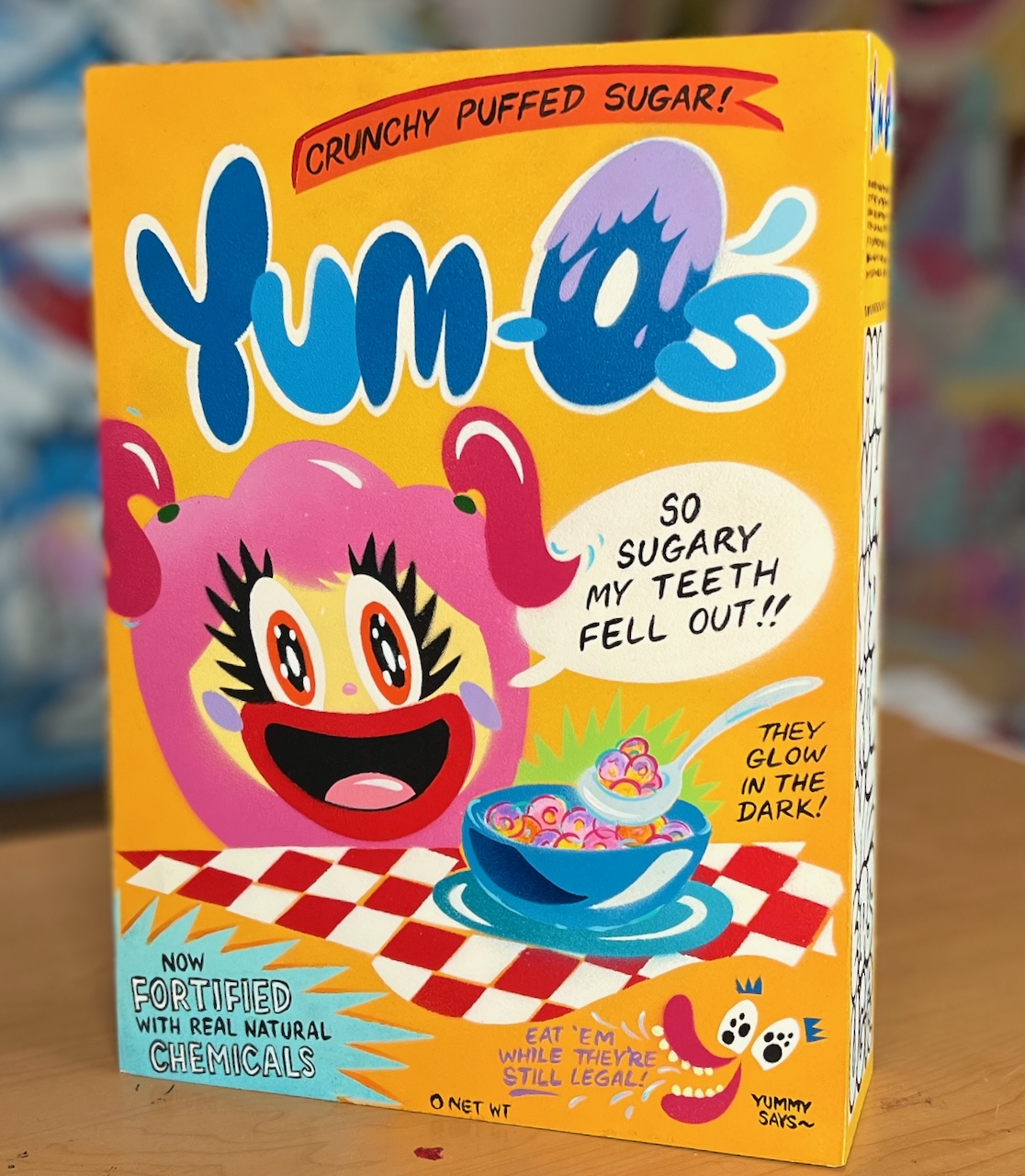
(Photo by John Griswold)
He opened an unfinished, large-format, graphic novel made with stencils. He had shown parts of it at the Alternative Press Expo in San Diego. Murder Won’t Stop Shooting was inspired by violence in Chicago.
“It’s about this guy, he gets killed, and his brother [finds old Game Boys in dumpsters and makes a device] and, like Frankenstein, brings him back to life. [A]nd he takes out the gangs in Chicago. [S]omeday I’ll finish it. But beautiful pages…don’t you think?”
He remembered again his mentor Cortland Anderson’s kindness. “[H]e really wanted to send my comic strips to the [Washington Post] syndicate…. And he kept saying, ‘Make it more Doonesbury.’ They really wanted a younger social commentary. But he died! He was such a great guy, too. And you know what was so great about him? He was the first guy that believed in my ability, and he also got me out of statistics. [E]veryone needs someone like that.”
He asked if I had someone like that in my past. I said, yes, a writer named Jim McNiece, who told me before I graduated that writing would be my life’s work, but not to starve doing it.
“Wow! How’d he know?” Dempsey enthused. “Because if you read your writing you’d never guess it. No, so he really believed in you. Yeah! Wow.”
He showed us one of his series of botanical paintings, and I said I loved it.
“YOU DO?” he said hyperbolically.
My son said he liked it too.
“YOU DO?”
“You don’t want that one,” I said, envisioning it leaning against a full dumpster later that afternoon. “I’ll take it. You don’t even like it. It’s got tomatoes in it.”
“So anyway,” he said, ignoring me and straining to slide it back into its bin.
• • •
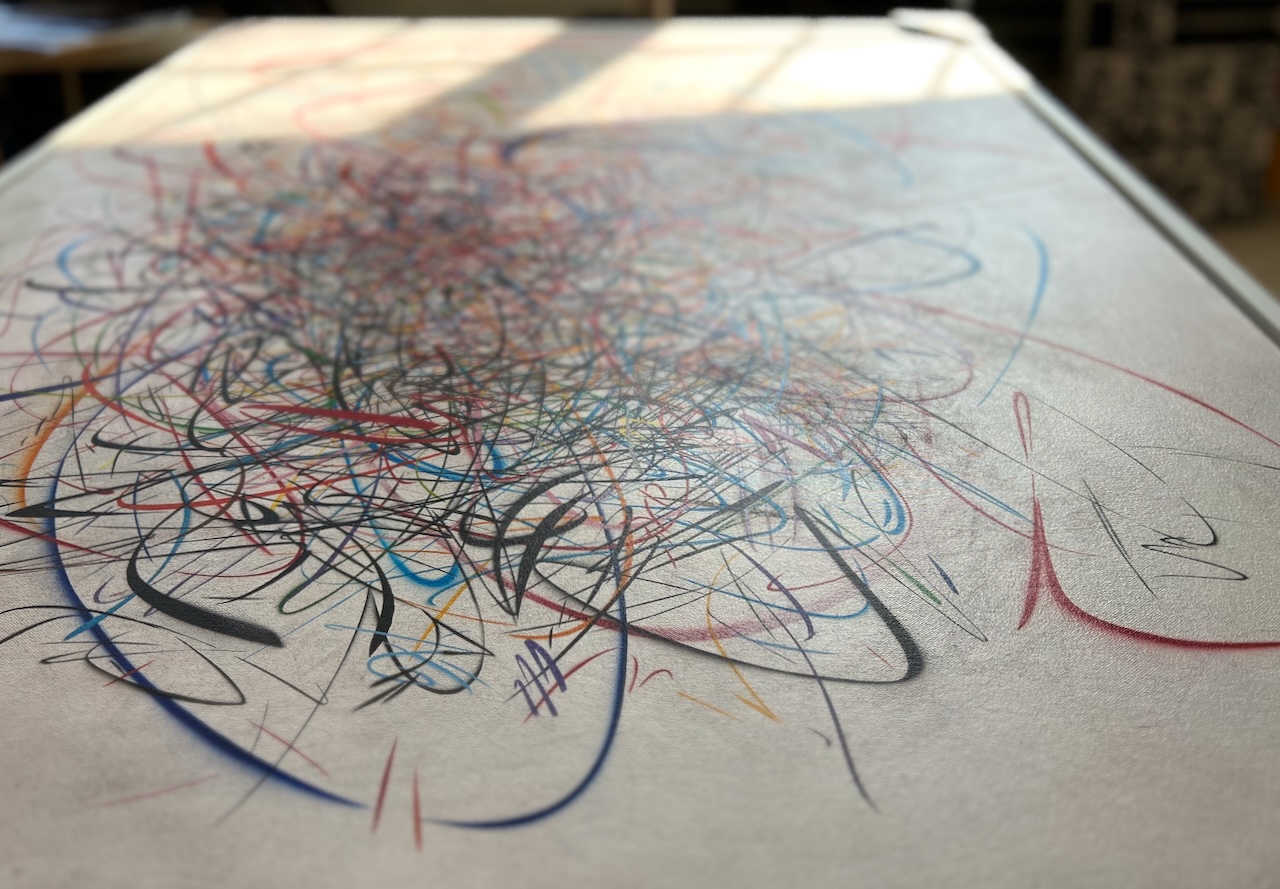
(Photo by John Griswold)
I bet John Dempsey is a great dad. He is a genius at participatory innocence.
“Alright. We’re gonna do some artwork here, guys,” he told us near the end of our visit. He put his Monopoly-tycoon stencil on some art board and placed little metal screws on it to press the delicate shapes flat. The paint can went clackclacka.
“I love this piece,” he said, “because it’s a pro-union image.”
He sprayed the paint efficiently and quickly, keeping the smell down, and told me to pull up the stencil for the reveal. It had a splatter effect; he said Ralph Steadman was a huge influence. He fussed with the finished piece and told me I should be the one to sign it, because I had peeled up the stencil. I laughed, which spurred him on.
He got more animated, as if doing a new character—Billy Tokyo himself, maybe, or a character called “The Interviewed.” His speech poured out performatively, but that did not necessarily make it untrue.
“Do you still like that guy, he’s The Painter of Light?” Dempsey made his face a mask of intense interest. “Does those cottages? Do you still collect him?”
He asked if my son knew that Kinkade mixed his own blood in the paint sometimes. “It’s DNA. Thomas Kinkade DNA!” he said, being a marketer now.
I said Kinkade’s stores used to be in all the malls. Dempsey pretended to hear “walls.”
“In your house?” he said innocently. “You know, I’m really honored that you put me into the same collection as Thomas Kinkade!”
“I feel bad,” he said, still fussing over the stencil painting. “This one kind of got ruined a little bit. Do you want another one?”
He did another one. He said it was right this time. He looked closer.
“Wait a second, I just missed something,” he said. Clackaclacka.
• • •

(Photo by John Griswold)
From the start, I knew my story could never depend on John T. Dempsey IV getting serious with me. Rapid-fire joking is how he keeps things under control.
After our visit (the distance now safely returned), he admitted by email, “One of the other reasons I started using an alias is that it’s very hard for me to talk about my own work—the only time I get shy…. I could always talk about other artists’ and friends’ works and promote them. By using a different name I thought I could talk about this other person [Billy Tokyo] more and promote my/their work—and it turned out I could.” Then he doubted that he had on our visit.
Does it matter if an artist wants to (or can) explain their work? We like to believe it does, but it might be that we hope to possess knowledge about being talented, expressive, prolific, and relatively free. The real story is right there, already framed, hanging on the wall: To work—seriously, discerningly, and with endurance through a life—is a kind of heroism.
